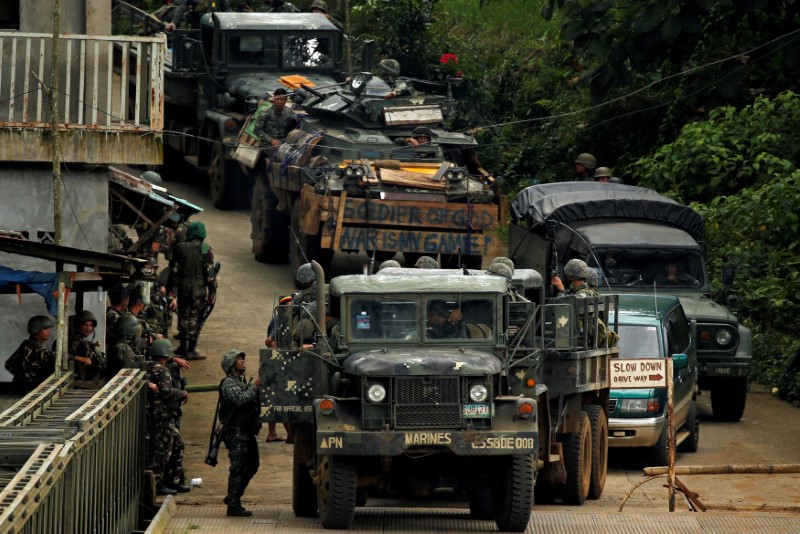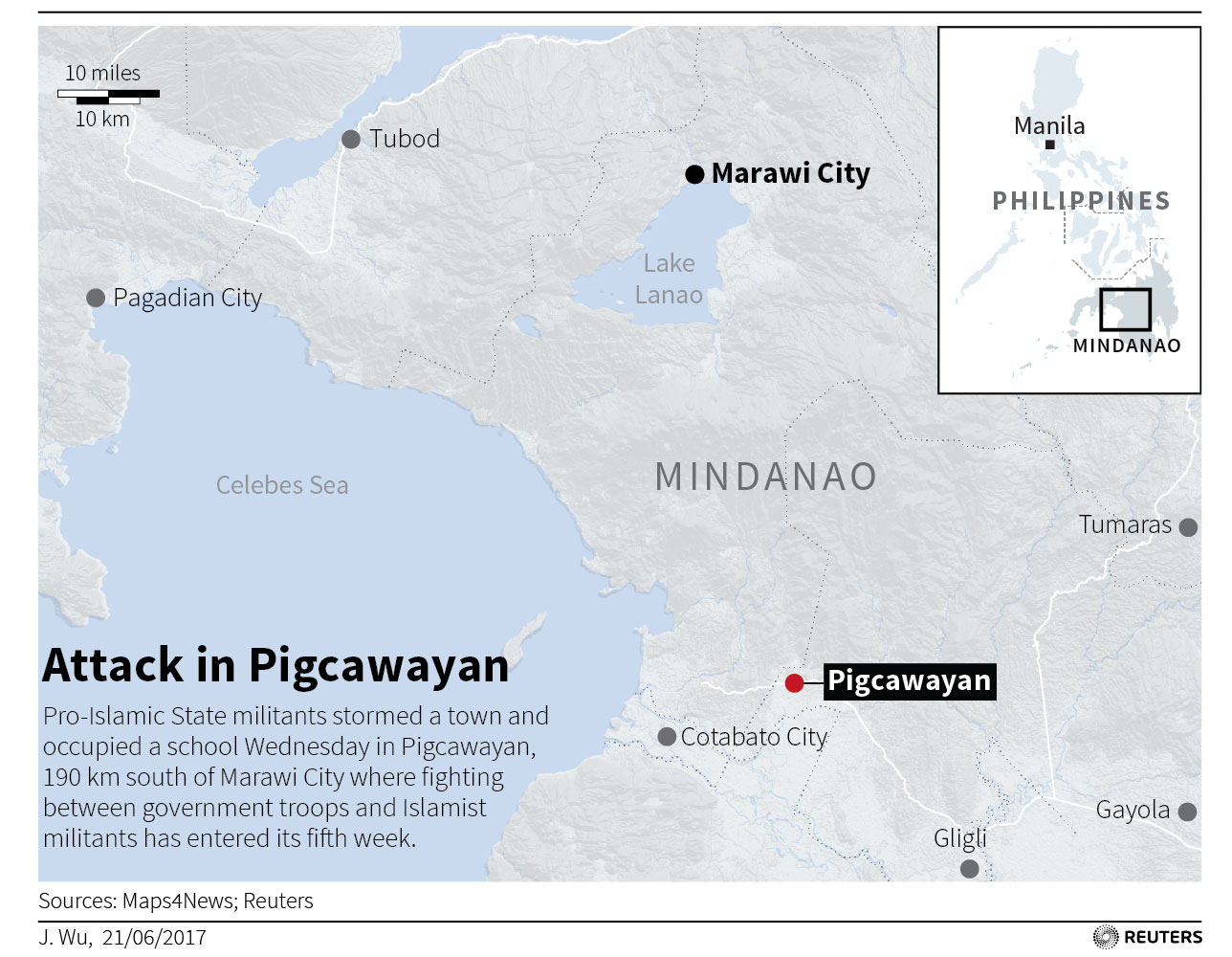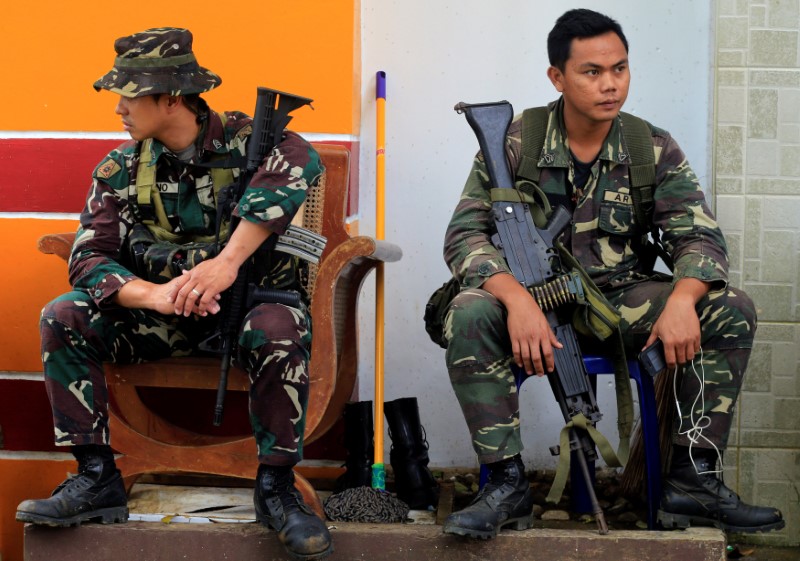
By Kanupriya Kapoor
MARAWI CITY, Philippines (Reuters) – The decapitated bodies of five civilians have been found in a Philippine city occupied by Islamist rebels, the military said on Wednesday, warning the number of residents killed by rebel “atrocities” could rise sharply as troops retake more ground.
The discovery of the five victims among 17 other bodies retrieved would be the first evidence that civilians trapped in besieged Marawi City have been decapitated during the five-week stand by militants loyal to the Islamic State group, as some who escaped the city have previously reported.
Lieutenant Colonel Emmanuel Garcia of the Western Mindanao Command said in a text message to reporters the five decapitated were found with the other 17 civilians killed by militants.
Garcia did not respond immediately to repeated requests for more details.
It was not clear when the bodies were found. A civilian rescue worker, Abdul Azis Lomondot, told Reuters earlier there were body parts found on Wednesday, but there was “no proof of beheading”.
The battle for Marawi entered its 36th day on Wednesday, with intense gunfights and bombing in the heart of the town and black-clad fighters seen from afar running between buildings as explosions rang out. Marawi is on southern Mindanao island.
The rebels’ hold on Marawi, while incurring the full force of a military for years trained by its U.S. counterparts, has much of the region on edge, concerned that Islamic State’s influence may run deeper than thought.
Those fears are also being felt in Malaysia and Indonesia, whose nationals are among the Maute group of rebels fighting in Marawi, suggesting the group may have built a cross-border network that has gone largely undetected.
Military spokesman Restituto Padilla said it was likely that many civilians had been killed and the death toll – already at 27 before the latest 17 were announced – was only what the authorities could confirm independently. He said a “significant number” of dead had been seen by those who had escaped fighting.
“(It) may increase significantly once we are able to validate all this information,” Padilla told reporters.
“There have been a significant number that have been seen but again, we cannot include many of these,” he said.
Padilla said the cause of those deaths would be “atrocities committed by the terrorists”.
Among those atrocities, the army says, have been residents being forced to loot homes, take up arms, or become sex slaves.

Philippines army soldiers return from an operation to retrieve bodies of casualties from the fighting zone in Marawi City, Philippines June 28, 2017. REUTERS/Jorge Silva
SEVERE IMPACT
Videos have appeared this month on the website of Islamic State’s Amaq news agency and its social media channels of hostages in Marawi pleading for their lives, saying they would be beheaded if air strikes were not stopped. Clips have also appeared of people on their knees, shot in the head from behind.
Reuters was unable to confirm the authenticity of the reports.
The military has so far been reluctant to discuss the possibility that the real impact of the fighting on civilians could be far more severe than has been reported.
It has played down the impact of daily air strikes and mortar assaults aimed at rebel sniper positions, which have reduced areas of the lakeside town to rubble and alarmed people stuck there, some of whom have said the shelling was a bigger threat than the militants.
Disaster officials are keen to start dangerous missions to recover what they believe are large numbers of bodies in the streets near the conflict zone.
President Rodrigo Duterte said on Tuesday he was prepared from the outset for a long fight against a well-armed Maute motivated only by murder and destruction.
“It seems to be limitless supply. They were able to stockpile their arms,” he said.
“Some of those who traveled to the Middle East got contaminated, brought the ideology back home and promised to declare war against humanity.”
Military spokesman Padilla called for patience and said troops needed more time to flush out the gunmen and secure the city.
“Our combat environment is sensitive. First, there are trapped civilians that we have to protect. They also have hostages and third, there are many traps so we have to clear buildings slowly,” he said.
Some 71 security forces and 299 militants have been killed and 246,000 people displaced in the conflict, which erupted after a failed attempt on May 23 to arrest a Filipino militant commander backed by Islamic State’s leadership.
For graphic on battle of Marawi, click: http://tmsnrt.rs/2sqmHDf
(Additional reporting by Neil Jerome Morales in MANILA; Writing by Martin Petty; Editing by Robert Birsel and Paul Tait)











